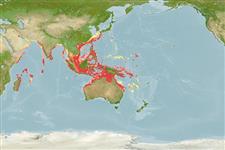Common names from other countries
Environment: milieu / climate zone / depth range / distribution range
Écologie
; profondeur 7 - 107 m (Ref. 125642). Tropical; 33°N - 27°S, 46°E - 168°E
Distribution
Pays | Zones FAO | Écosystèmes | Occurrences | Introductions
Indo-West Pacific: From Madagascar to India, reaching Japan and Australia.
Length at first maturity / Taille / Poids / Âge
Maturity: Lm ? range ? - ? cm Max length : 5.0 cm CW mâle / non sexé; (Ref. 343)
Found subtidal on sandy-muddy substrates, from depths of 7 to 107 meters (Ref. 125642).
Life cycle and mating behavior
Maturité | Reproduction | Frai | Œufs | Fécondité | Larves
Members of the order Decapoda are mostly gonochoric. Mating behavior: Precopulatory courtship ritual is common (through olfactory and tactile cues); usually indirect sperm transfer.
Ng, P.K.L. 1998. (Ref. 343)
Statut dans la liste rouge de l'IUCN (Ref. 130435)
statut CITES (Ref. 108899)
Not Evaluated
Not Evaluated
Menace pour l'homme
Harmless
Utilisations par l'homme
Pêcheries: commercial
| FishSource |
Outils
Sources Internet
Estimates based on models
Preferred temperature
(Ref.
115969): 24.6 - 29, mean 28 (based on 1358 cells).
Vulnérabilité
Low vulnerability (10 of 100).
Catégorie de prix
Unknown.
